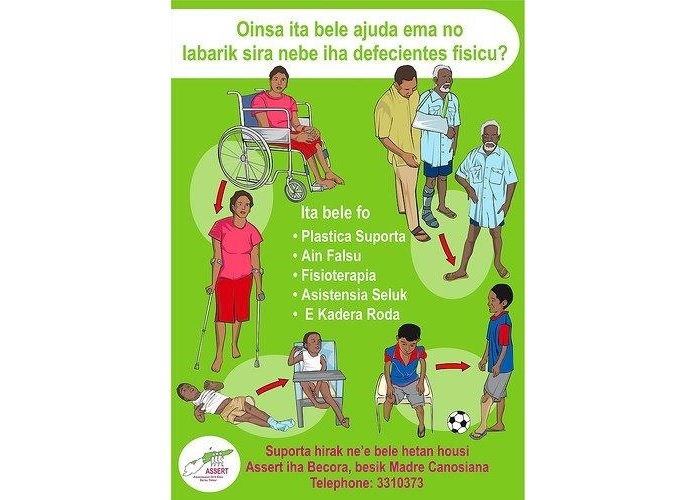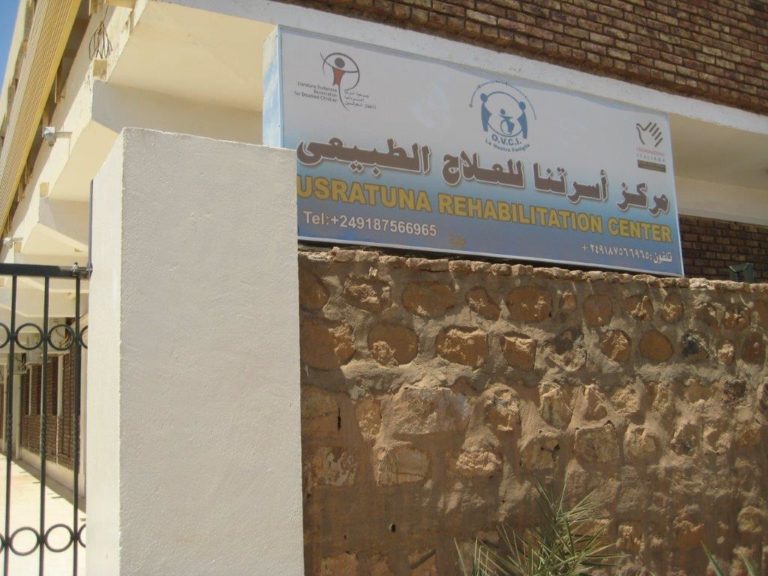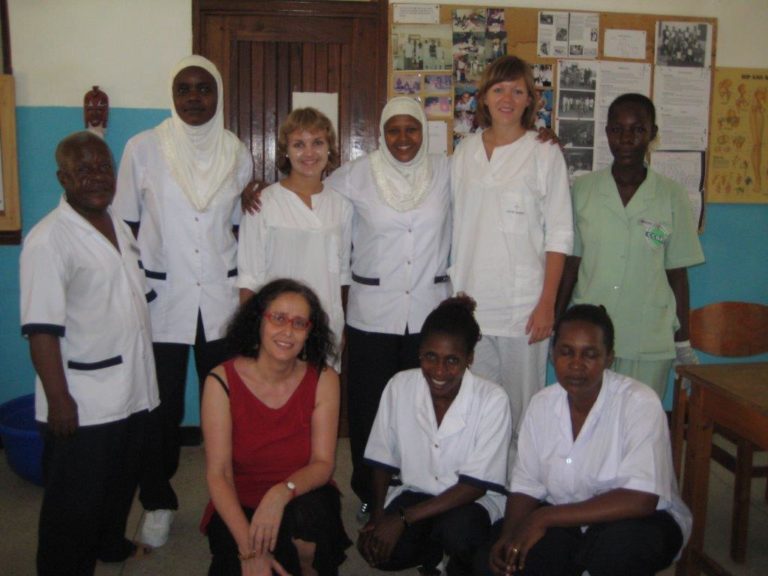Workplace rehabilitation in developing countries
 This is a poster from the rehabilitation centre in Tanzania, illustrating their work. This rehabilitation centre works both with adults and children, to improve their function level. © G.Van Den Bergh
This is a poster from the rehabilitation centre in Tanzania, illustrating their work. This rehabilitation centre works both with adults and children, to improve their function level. © G.Van Den Bergh
Work is essential for most people. A work salary pays for food, clothes and housing. If you become sick or disabled in any way and cannot work, and thus, do not earn your salary, you have a problem. Some countries have social benefits that can help you in such situations, but other countries do not provide such support. It is important to realize that many countries do not have any social benefits for handicapped and disabled persons, and this makes rehabilitation difficult. This lack of support in many countries makes this lecture especially important. It is necessary for stakeholders and policy-makers to become more aware of the possibility of also including handicapped persons in working life.
Here is the WHO definition of rehabilitation:
“Rehabilitation of people with disabilities is a process aimed at enabling them to reach and maintain their optimal physical, sensory, intellectual, psychological and social functional levels. Rehabilitation provides disabled people with the tools they need to attain independence and self-determination.”
Work rehabilitation is a broad term that encompasses many aspects of intervention, all focused upon facilitating independence at work as well as enabling workers to fulfill a worker role.
The expression “rehabilitation” was developed after the World War I, when it was deemed socially important to support and re-integrate mutilated war veterans. Training schools, hospitals and various institutions were founded and programs started to develop. However, in reality, the development was rather slow in most countries, despite their heavy involvement in the war. After the World War II, new rehabilitation programs were established, and this time with more support and strength. Both national authorities and different kinds of organizations started to work support and re-integrate disabled persons who had participated in the war. The idea of bringing disabled persons back to the working life expanded further, and other disabled groups in society were included in rehabilitation programs. Departments of Rehabilitation were established at hospitals and medical schools. For a long time the main focus of these activities was related to persons who had experienced an amputation, stroke, spinal injury or limb destruction. Later, rehabilitation techniques have been used also for other patient groups, including for instance patients with mental health problems as well as drug abusers. Organizations and associations established by the patients themselves have been of major importance in rehabilitation issues; associations for blind persons, deaf persons, persons with poliomyelitis and so on. These types of organizations have often succeeded in altering negative attitudes in the society towards the different patient groups. In many low income countries of today, rehabilitation has a relatively minor role in the health system. However, the idea is becoming more and more acknowledged among health personnel, and rehabilitation units are becoming established in a growing number of places. For instance, the International Committee of the Red Cross (ICRC) reports that over 235,000 people received treatment at ICRC physical rehabilitation centres worldwide between January and September 2015. This is promising! You can read more about these rehabilitation projects here.
Why rehabilitation
The estimated figure for the number of disabled persons in the world is around 15 percent of the population. This is a large number. It also represents a large number of potential workers. Many disabled persons could do a decent job if they were given the opportunity. In many cases, relatively minor support could give the society a productive worker. It is better for societies to consider disabled persons as a resource, rather than as a problem. One of the reasons why rehabilitation programs started up after wars is of course the increased influx of persons with injuries and health problems. Another reason has been the increased need for a strong work force after wars. Wars destroy important infrastructures, and in the aftermath of such negative events, it is important that as many persons as possible participate in the reconstruction of the society. However, the idea of including persons with disabilities in the working life does not have to be related to post-war situations. Persons with some disability can be a major resource in many types of work. It is common in several countries that disabled persons are not actively engaged in paid work It is very difficult to obtain concrete data about the issue. In Zimbabwe, for example, less than 1 per cent of disabled people formally participate in the workforce. A similar situation may exist in many other low income countries. Higher numbers of employed disabled workers are reported in middle income countries, such as for instance Paraguay, where 18.5 per cent of people with disabilities are employed in the formal workplace. In high income countries, the percent of employed disabled persons can be 50, or more. The amount of social infrastructure a given society has, determines how possible it is for disabled persons to get help and be able to work. Rehabilitation is an issue that involves actors across the whole of society. For instance, in Ethiopia today, a small but growing number of programs at a national level provide education and job skills training to people with disabilities. In addition, at the regional level, the government has established rehabilitation centres in seven regions and plans are underway to establish additional centres in those regions currently without them. Centres that are already in operation were initially planned to provide services to those injured in the military but now provide services to people with different types of disabilities. Such programs currently concentrate on providing rehabilitation, but have not yet been expanded to include job training or skills-building programs. Those programs that do provide job training, including development or rehabilitative care are important, but these programs are currently very small in scale. While programs such as these are significant steps forward, such efforts will need to be expanded and made available beyond primarily urban areas if a substantial dent is to be made in the number of people with disabilities living in poverty. On the web pages of ILO you can find the document: “Managing disability in the work place. ILO code of practice”. “Managing disability in the work place. ILO code of practice”. Also, it is important to know that in 2006, the UN General Assembly adopted the International Convention on the Rights of Persons with Disabilities. It requires countries to ensure that people with disabilities are granted equality under the law and freedom from discrimination, and is a milestone in the fields of disability and human rights. “UN General Assembly adopts International Convention on the Rights of Persons with Disabilities”.
 Beggar in the street. © Colourbox
Beggar in the street. © Colourbox
Beggars
Beggars are a problem in many large cities in low income countries; in Ethiopia for instance. A report from ILO (Disabled beggars in Addis Ababa, Ethiopia, 2013), has studied disabled beggars. For persons with a disability, begging can be their only means of obtaining money and food. Most of disabled beggars in Addis have serious physical disabilities or are blind. Many of them have come from other parts of the country. Some have left their family and come to Addis because they thought they could find a cure for their health problems. When this was unsuccessful, they started begging for a living. They have a social stigma and when excluded from family and community networks, it is often difficult or impossible for people with disabilities to find any paid work. Disabled beggars are a very visible group of persons who need rehabilitation. Read more about the topic “Disabled Beggars in Addis Ababa, Ethiopia” here.
Work place rehabilitation
Work place rehabilitation can take place in two main types:
a) The first occurs when a worker becomes injured or develops a disease that makes it difficult to perform the work tasks. The injury or disease can be caused by the work situation, but rehabilitation is also needed when injuries or diseases develop from other causes. The aim of the rehabilitation process is to help workers to continue their work despite the development of disability and reduced function level.
b) The second concerns making work possible for disabled and handicapped persons. Some persons never start a career at any work place, due to an injury or disease that developed early in their lives. About 15% of the population of the world has some kind of disability, and it can be difficult for them to work “normally”. In many cases, however, rehabilitation help can be an important process towards making some kind of work possible even if a disability or handicap is present.
It is important to remember that people with disabilities are not a homogeneous group. They may have a physical disability, a sensory, intellectual or mental disability. They may have had a disability from birth, or acquired this in their childhood, teenage years or later in life, during further education or while in employment. Their disability may have little impact on their ability to work and take part in society, or it may have a major impact, requiring considerable support and assistance. This makes rehabilitation work quite challenging.
 A rehabilitation centre in Sudan. © G.Van Den Bergh
A rehabilitation centre in Sudan. © G.Van Den Bergh
Who works with rehabilitation?
Rehabilitation often takes place in hospitals. People with skills that are important for rehabilitation can include physiotherapists, physicians or nurses with specific education and training. Some hospitals are specialized in the rehabilitation of patients with specific diseases. Some hospitals have special rehabilitation departments. Special technicians can develop and produce technical support and aids for the patients. Some countries have specific rehabilitation institutions. Rehabilitation is an important part of the work in occupational health services. In work place rehabilitation, the practitioners are trained to evaluate individuals’ interactions with their work demands and the work environment through examination of the worker and work task analysis. Such evaluations can identify the supports and barriers to success in the work environment , and which, if indicated, could be addressed in an intervention plan in order to facilitate work performance. Some countries have defined a specialty called “Occupational Therapy” which focuses on work place rehabilitation. However, rehabilitation work is multidisciplinary and teams of professionals are needed for the most successful results. Rehabilitation is important for the individual worker. In addition, rehabilitation is important for the society. Dignity and quality of life are key issues. All societies should aim to help disabled persons to become a part of working life.
 A multidisiplinary rehabilitation team. © G.Van Den Bergh
A multidisiplinary rehabilitation team. © G.Van Den Bergh
Some large companies have established their own rehabilitation departments. They can thereby build-up their own competency for assisting their own employees to be helped back to work in the event of injury or illness. It can be expensive for the companies to train new workers, thus taking care of workers can be of great economic value. In addition, this type of care increases the loyalty of the workers, and the value of loyalty can be high.
Share this
Occupational Health in Developing Countries

Occupational Health in Developing Countries


Reach your personal and professional goals
Unlock access to hundreds of expert online courses and degrees from top universities and educators to gain accredited qualifications and professional CV-building certificates.
Join over 18 million learners to launch, switch or build upon your career, all at your own pace, across a wide range of topic areas.
Register to receive updates
-
Create an account to receive our newsletter, course recommendations and promotions.
Register for free







